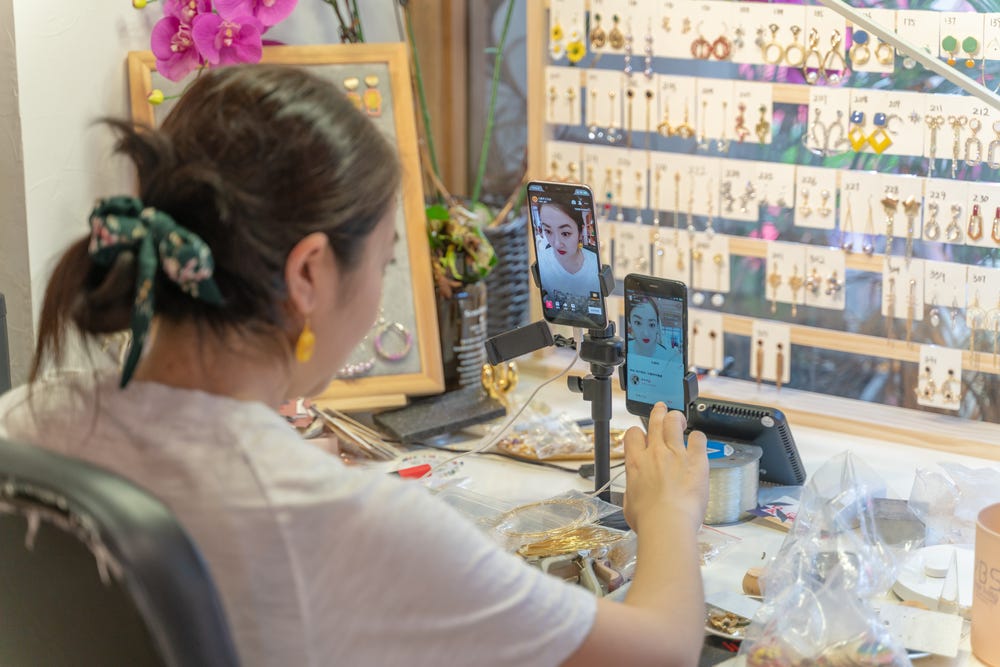Future Tech China: The Challenges Ahead for China’s Short Video Platforms
Plus: E-Commerce livestreaming goes global, Canada Goose taps Angel Chen, and Prada learns a lesson.
Published three times per week, the Content Commerce Insider newsletter highlights how brands create content to drive revenue, globally. If you have received our newsletter from a friend or colleague, we hope you will subscribe as well and follow us on LinkedIn and Instagram.
China’s popular short video apps Douyin and Kuaishou may find themselves in a bit of a bind soon. Why?
High penetration rate: User penetration reached ~80% in March 2020 and then stagnated at around 75% for the rest of the year;
Slowing growth: Growth in monthly active users (MAUs) declined from 20% in 2019 to 8% in the third quarter of 2020; and
Monetization rates and business models vary wildly in the market.
The high penetration rate means that short video platforms (which also incorporate livestreaming and longer content such as films and serial programming) have been pretty successful overall. But it also means that growth opportunities are slowing down, and the solution lies in the monetization model.
The general consensus is that it’s looking good for Douyin, not so much for Kuaishou, and, as for WeChat’s Channels… Outside of mini-programs, Tencent doesn’t really seem to care about WeChat’s monetization as much. Read on to learn about the breakdown.
Kuaishou’s Business Model
Loss-making Kuaishou has officially filed for its IPO in Hong Kong, aiming to debut on the exchange in early February. The platform famously lost more than $1 billion in just six months last year, but it did so for a reason.
Instead of focusing on revenue, Kuaishou has been playing the world's most popular tech startup game: user acquisition first, profits second. We’ve seen this happen with China’s e-bike wars before, and now it’s happening again in various sectors: community group buying, food delivery, and (of course) video streaming, among others.
Kuaishou’s emphasis on user acquisition has paid off: While marketing expenses tripled between the first half of 2019 and the first half of 2020, it gained 100 million daily active users (DAU), exceeding 300 million DAUs by mid-year. But like many startups that have focused only on customer acquisition in the past (looking at you, Uber), Kuaishou still struggles with profitability.
Its core business model is based on a combination of livestreaming revenue (via micro-transactions such as virtual gifts from fans), advertising, and e-commerce. While advertising accounted for just 28% of total revenues, livestreaming was by far the biggest source, representing 69% in the first half of 2020. When viewers send virtual gifts to performers, Kuaishou takes a cut. Virtual gifts can run from as little as RMB 1 (15 cents) to RMB 2,000 ($300), but the business has slowed and is very likely to enter a negative growth stage, according to analyst firm Jioupai, thanks in part to new regulations on livestreaming and virtual gifts.
More importantly, Kuaishou has been working hard to scale its e-commerce model to drive revenue. Perhaps it’s the influence of Tencent, which owns 21.6% of Kuaishou, or the fact that Kuaishou has proven more popular with users in lower-tier cities, typically resulting in a smaller average order value (albeit at a higher volume), but e-commerce hasn’t yet become a major part of Kuaishou’s business. Its e-commerce monetization rate (电商体量的货币化率) remains low at 1%. In contrast, Alibaba’s Taobao has a monetization rate of 3.9%, while Tmall's hovers around 5-6%, and Pinduoduo’s is 2.9%. Kuaishou rival Douyin hasn’t released comparable figures yet, despite its heavier push into e-commerce.
Of course, part of the reason why the monetization rates for Alibaba’s Taobao and Tmall are so high is that consumers generally open those apps with the intent to buy, giving them an advantage compared to Kuaishou or Douyin, where users go to be entertained first and foremost. Furthermore, Alibaba controls the entire vertical, from the video content on the platform to the marketplace, logistics, payments, and everything in between.
Compare this to Kuaishou, which has partnered with JD.com for integration with its app. Users can view JD.com products in the Kuaishou app, such as via a livestream, and make purchases from JD.com, but JD.com will take a cut through transaction fees (5-8%), while Tencent gets a share as well from WeChat Pay. Kuaishou may need to come to terms with the fact that livestreaming in itself is not very profitable without control over the entire transaction loop.
- by Tanya Van Gastel
Mentioned in today’s newsletter: Adidas Originals, Alibaba, Bilibili, Canada Goose, Douyin, H&M, JD.com, Kuaishou, Mercari, Netflix, Pinduoduo, Prada, Shiseido, Tencent, Uber.
China’s Gen Z and millennial consumers seek novel products that stand out from the crowd, fueling a rapidly evolving culture of innovative “mega-collaborations” between brands.
While many brand pairings may appear extreme or even bizarre, such items are widely talked about, and their freshness and limited-time appeal can tempt young consumers to at least try new, (often affordably priced) products—which also make them attractive candidates for posting on social media, further helping to expand the reach of brands among that valuable demographic.
Register today to join the Jing Group on Tuesday, January 26 at 10 a.m. EST / 3 p.m. GMT for a live webinar exploring “How Collaborations Are Defining Experiences in China”.
CCI Take: E-Commerce Livestreaming Hits the Global Mainstream
by Avery Booker
Livestreaming has become big business in China in recent years, as platforms and brands alike have seized the opportunity to reach consumers and nudge them along the path to seamless online purchases. From its initial roots in entertainment, where it was used by hopeful singers, comedians, and other performers to stream to fans (in exchange for virtual “gifts”), livestreaming has evolved into a critical area of focus and investment for e-commerce giants like Alibaba and JD.com as well as video platforms such as Douyin, Kuaishou, and Bilibili.
In China, the coronavirus pandemic saw e-commerce livestreaming expand its reach as celebrities, CEOs, salespersons, chefs, personal trainers, musicians, and fashion influencers got on the bandwagon. According to data from China’s Ministry of Commerce, more than 10 million livestreaming e-commerce programs were broadcast in the first half of last year alone, attracting more than 50 billion views and promoting more than 20 million products.
This translated to more than just a great deal of consumer attention, driving a flood of spending. A recent report by KPMG and Ali Research projected that China’s e-commerce livestreaming market would reach RMB 1.05 trillion ($154 billion) in 2020, up from RMB 433.8 billion ($66.8 billion) in the previous year. Now, e-commerce giants such as Alibaba and JD.com find themselves competing with nimbler platforms that are popular with China’s millennials and Gen Z.
While it is arguably the most advanced e-commerce livestreaming market in the world, China is not the only place where the format is taking off. The immediacy and spontaneity of livestreaming increasingly appeals to younger consumers who are more resistant to traditional marketing and advertising and may prefer to turn to trusted influencers to discover products and even make purchases. Meanwhile, performing artists who have been denied the ability to do live shows are using livestreaming as a much-needed lifeline to connect with fans, sell merchandise, and make ends meet.
Japan
E-commerce livestreaming is still in its relative infancy in Japan, with some of the country’s most digitally savvy brands such as Shiseido using the format to sell products to Chinese consumers using Chinese platforms while taking tentative steps to introduce consumers to the concept back home. A lack of familiarity with e-commerce livestreaming in Japan has led some companies, such as community-powered marketplace Mercari, to put their efforts on ice.
Read the full article on Content Commerce Insider
Brand Collab Pick: Canada Goose x Angel Chen
Shanghai-based designer Angel Chen has been much in demand by global fashion brands, drawing international attention with her appearance on Netflix’s “Next in Fashion” and creating capsule collections for the likes of Adidas Originals and H&M.
Chen has gone upscale in her latest partnership premium outerwear brand Canada Goose, presenting a capsule collection last fall that was recently released for sale. The collaboration is the Canadian brand’s first foray into featuring a guest designer, and the result is a 13-piece collection with pieces that span winter and spring for broader appeal.
Chen’s streetwear-meets-couture aesthetic is reflected in her designs for Canada Goose, with voluminous silhouettes and the incorporation of Chinese traditional elements that will appeal to fans of the guochao (“national trend”) style as the brand seeks to expand its footprint in the Chinese market.
The collection is also available globally through Canada Goose retail outlets and online. “I love the idea of presenting our tradition, history, and design to the world,” said Chen. “With a play on versatility, we combined aspects of both our signatures: bold color from me and the hero pieces from Canada Goose to construct a new transformative style that tips into eastern and western aesthetics. That's always been a trademark of my designs.”
News From China
The ticking celebrity time-bomb that was Zheng Shuang officially imploded with a “massive” scandal over her alleged abandonment of two children born via surrogacy in the United States.
The bad news hit Prada particularly hard — the Italian fashion house had recently appointed Zheng as a brand ambassador and featured her prominently in its Lunar New Year campaign, and its Hong Kong-listed shares took a hit as Zheng’s scandal went viral on Chinese social media.
Zheng was seen as an odd choice for an intellectually-oriented luxury brand such as Prada. Though popular, with more than 10 million followers on Weibo, Zheng is not considered a serious actor, known for her fairly light roles on TV and an off-screen reputation of being very outspoken and somewhat immature. Zheng has also failed to come through for brands in the past, as in the disaster that was her e-commerce livestreaming debut on Kuaishou last year, when she had an on-air meltdown and refused to talk about the products she had been paid to promote.
Prada was quick to distance itself from Zheng, issuing a statement that it had severed ties with her just a week after she was announced as a representative for the brand. And while Prada’s Hong Kong-listed shares have rebounded, the brand’s major Spring Festival campaign will require some significant editing. This latest celebrity misfire should serve as a cautionary tale for brands to do their due diligence to assess potential risks rather than seeking out drivers of short-term traffic.
Winners and losers in Spring Festival sponsorships: Also taking a hit from negative publicity is social commerce platform Pinduoduo, which has been under fire for a culture of overwork that is being blamed for employee deaths.
The company reportedly withdrew as the planned lead sponsor of the CCTV Spring Festival Gala (aka the world’s most-watched TV program) on February 11 as a result, paving the way for Douyin to step in to give away many millions in virtual red envelopes to viewers during the broadcast.
Douyin will also be the exclusive title sponsor of Beijing TV’s February 12 Lunar New Year gala show, with JD.com serving as a strategic partner. Last year, Douyin was involved in a total of seven Spring Festival gala shows as a sponsor or partner as part of its much-publicized effort to give away RMB 2 billion during the holiday period, while Kuaishou claimed the prized CCTV sponsorship.
News in English
Jack Ma made his first public appearance in three months, appearing in a brief video address to rural teachers that was published by state media. CNN
The value of mini program transactions on WeChat reached nearly $250 billion in 2020, double the previous year’s level. Techcrunch
Chinese imports of consumer goods rose more than 8% in 2020, as e-commerce players such as Alibaba and JD.com tout international brands as a draw for shoppers unable to travel overseas. SCMP
Douyin has launched its own mobile payment platform, called Douyin Pay, as part of its ongoing effort to create a closed-loop e-commerce ecosystem. Reuters
Luxury brands are targeting lower-tier Chinese cities as potential fashion hubs, though offerings need to be tailored to local tastes rather than just reproducing what works in places like Beijing and Shanghai. SCMP
Eight ways that brands can work with Chinese influencers, from sending products to incubating their own talent. Parklu
Chinese fast-fashion sensation Shein is partnering with young designers from around the world on trendy collaborations. WWD
How global brands can take advantage of Chinese consumption trends to boost cross-border e-commerce during the Spring Festival holiday period. Azoya
Huawei heiress Annabel Yao’s attempts to become an entertainer/influencer/entrepreneur in the Kardashian mold appear to have backfired amid derision over her recent self-promoting publicity blitz. New York Times
The Nasdaq-listed game streaming platform Douyu is the latest target of short sellers, who allege the company is allowing illegal gambling activity. Variety
We’ve Got China Covered
China Film Insider: Top Performing Foreign Films in China in 2020
Jing Daily: The New Digital Playbook for Luxury in 2021
Jing Culture & Commerce: The Video Game Intent on Redefining the Art Audience









